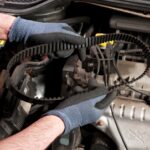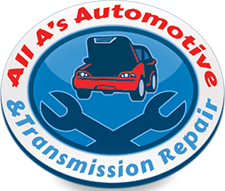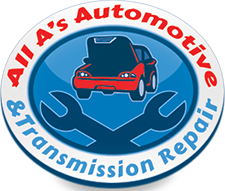What Are The 8 Signs Of A Bad Timing Belt?

 Have you ever taken your car somewhere and it just didn’t feel like it was driving right? Maybe you can’t put your finger on it, or perhaps the super loud bang of an engine misfire tipped you off. With this scenario in mind, I would like to discuss something you may not be aware of. Some auto components require infrequent service and long replacement intervals. Drive belts fall into this category. Below, I discuss how routine inspections and auto maintenance of your car’s timing belt or timing chain can reduce expensive engine repairs.
Have you ever taken your car somewhere and it just didn’t feel like it was driving right? Maybe you can’t put your finger on it, or perhaps the super loud bang of an engine misfire tipped you off. With this scenario in mind, I would like to discuss something you may not be aware of. Some auto components require infrequent service and long replacement intervals. Drive belts fall into this category. Below, I discuss how routine inspections and auto maintenance of your car’s timing belt or timing chain can reduce expensive engine repairs.
What Is A Timing Belt?
A timing belt is an important component that connects your internal combustion engine to the crankshaft and camshaft. The timing belt contains materials like rubber, polyurethane, or neoprene. You can find it near the front of the engine, inside the timing cover. The timing belt ensures synchronized rotation of the cylinders for complete combustion. Your vehicle will not operate efficiently with a bad timing belt.
Some Cars Have A Timing Chain
Some older model vehicles or high-displacement engines use a timing chain instead of a timing belt. You can find the timing chain at the front of the engine, attached to gears and pulleys that supply power to multiple components. The timing chain looks similar to a bike chain, consisting of a series of metal links that connect to sprockets on the ends of the crankshaft and camshaft. Timing belts and timing chains perform the same basic functions.
8 Signs Your Timing Belt Is Failing
The warning signs noted below indicate that your timing belt or timing chain is worn out or broken.
1. Check Engine Light
The Check Engine Light on your dashboard is part of an early-warning system. When the light illuminates, your vehicle is experiencing an issue and requires immediate service. You can use an onboard diagnostics scanner (OBD-II) to read the error code that triggered the warning light. Or, you can schedule a diagnostic appointment with your local auto service center to determine the problem. Many different electronic or mechanical malfunctions can trigger the Check Engine Light. A trained technician can quickly determine if the timing belt is bad or if another issue is to blame.
2. Engine Misfires
You know that unexpected loud pop or bang sound that some cars make? Well, that is an engine misfire, which can be caused by a bad timing belt. A worn timing belt can change the opening and closing rhythm of your engine’s cylinders. When a cylinder fails to combust the air-fuel mixture completely, your engine will experience a loss of power and create a loud sound. Repeated misfires can damage your vehicle’s engine and catalytic converter.
3. Hard To Start
If your car won’t start after turning the key (or pressing the starter button), the timing belt may be worn or broken. Ignition cannot occur if the timing belt isn’t engaging the crankshaft and camshaft correctly. If your vehicle suddenly dies while driving and won’t restart, a bad timing belt may be the issue.
4. Increased Emissions
An imbalance in the fuel-air ratio can increase emissions and create a more smelly exhaust. If you notice a gasoline smell while driving or see visible smoke exiting the tailpipe, your timing belt may require replacement.
5. Overheating
Your vehicle’s engine can overheat when it is working harder than it should. A slipping timing belt can cause issues with combustion, resulting in increased heat buildup under the hood. Additionally, some timing belts also operate the oil pump and the water pump. When the water pump doesn’t circulate enough coolant through the engine, it will overheat.
6. Noisy Engine
You should never ignore noises in the engine compartment, since they are not typical in a correctly operating vehicle. Clicking, clunking, or squealing sounds can indicate a worn or failing timing belt. Schedule a diagnostic inspection right away if you notice any unusual engine noises while driving.
7. Reduced Fuel Economy
Combustion engines rely on precise timing to run efficiently. A worn or failing timing belt can noticeably reduce fuel economy due to incomplete combustion in the engine’s cylinders. If you are making more trips to the gas station, schedule an auto maintenance appointment to determine the cause of the issue.
8. Rough Idle
For most vehicles, the idling RPM should remain fairly constant. However, if your vehicle’s RPM range fluctuates rapidly during idling, schedule a diagnostic inspection right away. Replacing a worn timing belt before it breaks can help avoid expensive engine repairs down the road.
Auto Maintenance Spots Damage Early
A service technician performs a visual inspection of your vehicle’s timing belt (or timing chain) to identify signs of damage before it breaks. Here are a few things they look for:
- Cracks or excessive wear
- Frayed edges (or bent links)
- Missing teeth (or missing links)
- Oil leaking onto the belt (or lack of lubrication on the timing chain)
- Tension is too loose or too tight
Engine Repairs & Auto Maintenance
Many manufacturers recommend a timing belt inspection every 30,000 miles, and replacement every 75,000 – 100,000 miles. If your vehicle uses a timing chain, refer to your owner’s manual for recommended service and replacement intervals. Following your factory-recommended inspection and replacement intervals helps reduce the need for timing belt-related engine repairs. All A’s Auto Repair is a local, family-owned, independent service center and dealer alternative in Midland, MI. We offer outstanding service from certified technicians and a 24-month / 24,000-mile nationwide warranty.
Make An Appointment in Midland, MI
Give us a call at (989) 631-4672 for all your engine repairs and auto maintenance needs. You can learn more on our website and try our convenient online appointment form. We look forward to seeing you!
Posted in: Auto Diagnostics
Leave a Comment (0) ↓
